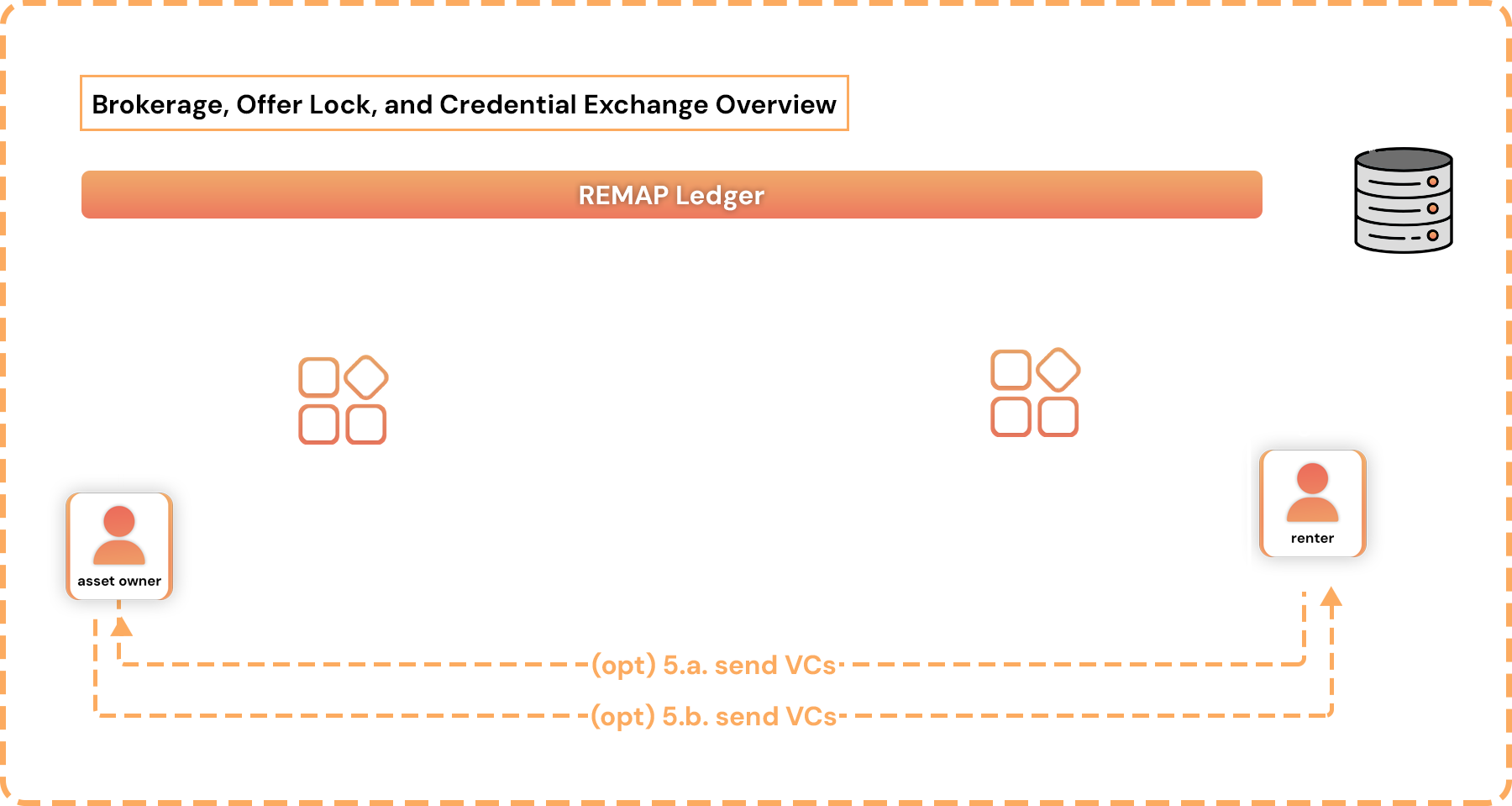Technology Stacks: Applications of REMAP – Modules and Interactions
Table of contents
- 1. Conceptual Architecture of REMAP
- 2. Technical Architecture Concept
- 3. REMAP Ecosystem Governance
- 4. Tokenomics
- 5. REMAP Token-Economic Design
- 6. REMAP Coin (RMC)
- 7. Starting the Ecosystem
- 8. Technology Stacks: Identity and Access Control in REMAP
- 9. Technology Stacks: Applications of REMAP - Modules and Interactions
- 10. Technology Stacks: Cosmos-Specific REMAP Architecture
Technology Stacks: Applications of REMAP – Modules and Interactions
In this section, we illustrate two applications of REMAP’s technical affordances. Specifically, we present possible approaches to designing asset rental and e-certification modules to support PropTech processes and highlight the underlying technical components employed as well as the interactions between them. In our description we rely on a future REMAP where smart contract capability is enabled such that a variety of assets or business logic can be stored and, respectively, be executed on-chain.
Peer-to-peer (P2P) Asset Rental
The P2P asset rental application describes the process of establishing a disintermediated rental agreement between a property owner and a potential renter. Below, we walk through several steps of the corresponding business flow and underline how identity elements of the SSI framework help secure and streamline such processes.
User Registration Module. User registration of a digital identity represents a first step in interacting with REMAP and may occur natively within REMAP or via independent identity systems (e.g., EBSI, ethr ). In the latter case, REMAP must be able to interoperate with the resulting identities, e.g., by providing an identity mapping service for external identities.
Asset Registration Module. Similarly, prior to listing their assets for renting, property owners must register them by creating a unique identifier. In doing so, the owner might need to first verify asset ownership through a proof-of-purchase such as a property acquisition VC. The asset registration module processes the VC and issues a DID for the asset to be controlled by its owner’s DID. Such approach relies on the assumption that acquisition proofs are issued as VCs. However, legacy systems may not implement the necessary SSI infrastructure on time (or apply it retroactively to existing documents). REMAP overcomes this deficit through verifiers which are system agents tasked with verifying the security of legacy documents and issuing corresponding on- or off-chain VCs, as applicable. Once ownership is confirmed, the registration smart contract issues an on-chain identifier (an NFT) that includes relevant characteristics of the asset such as physical attributes (e.g., surface area), condition, available utilities and services, and other applicable structural and regulatory details. Storing such details on-chain minimizes data fragmentation throughout the ecosystem and provides a single source of truth accessible to all REMAP users. Additional details (e.g., floor plans, 3D renderings) may also be stored off-chain to minimize storage costs, reduce bloat, maximize privacy, or enable compliance with data protection regulations such as the right to data erasure that can be enforced against offline asset catalogs much easier than against immutable ledgers. To allow for the integrity of such data to be verified, hatches of off-chain information can also be stored on-chain.

Figure 10: Asset Rental Brokerage Flow.
A potential renter reads asset listings by interacting with the asset listing module of a rental dApp. This module retrieves data from both on- and off-chain storage, providing available property information to the renter.
Brokerage Module. The renter selects one (or multiple) assets and submits offers to their respective owners. On their end, the asset owner retrieves offers received, and locks in the one that satisfies their constraints. Optionally, the potential renter and the owner exchange VCs for any additional checks. Matching rental offers and bids can unfold in several ways, through automated market makers, centralized brokerage nodes, smart contract automation by priority rules, or manually as traditionally practiced in today’s digital rental markets. REMAP supports the development of multiple such approaches, allowing the user to choose between them according to their constraints. For example, AMMs may be preferred when the user has complete flexibility over the outcome and wishes to outsource the computation, while manually selecting the asset could be preferred when, e.g., the user desires more interaction with the asset owner pre-renting. Once a bid is locked, the renter and the asset owner may perform additional off-chain identity and credential verifications, e.g., by disclosing financial or employment proofs as VCs which guarantee the authenticity and integrity of the information presented due to their tamper-proof nature.
Contract Establishment Module. After locking in an offer and clearing any additional verification steps, the asset owner initiates the creation of a rental contract. A rental agreement object is populated with contractual terms, such as the rental period or the asset identifier, derived from the offer and bid, as well as any applicable policies. Once both parties sign the contract, the smart contract component of the Contract Establishment Module mints the agreement as an NFT to both parties’ respective addresses. While a contract generally ends with the passage of time, either party may also initiate a contract cancellation. In such a scenario, the NFT is burned, any relevant penalties applied, and the asset unlocked to accept new rental bids.
Payment Module. Once a contract is established, the renter may need to pay a rental deposit to the asset owner as part of the conditions of the contract. At the same time, the renter must pay the rent at the frequency specified in the contract, e.g., monthly. The payment module enables secure token transfers between the two parties.
When compared to existing rental platforms, REMAP promises increased transparency by providing both property owners and renters with access to a more thorough, documented, and verifiable rental processes. At the same time, REMAP supports maintaining maximum privacy of user data through selective disclosure of VCs which can take minimally expressive forms such as “sufficient income”, as opposed to disclosing comprehensive financial statements. Similarly, renters can verify the fairness of the brokerage process by assessing competing bids against any disclosed owner preferences, as well as evaluate the value of the property based on additional information such as the rental history embedded in the NFT representing the asset, any recorded damages, or the owner’s rating. Throughout the asset rental processes, smart contracts serve as trustless intermediaries, automating execution and ensuring that stakeholders fulfill their obligations. In case of disputes, the blockchain acts as a timestamping service and can facilitate the resolution process by providing a history of commitments.
E-Certificate Issuance
The e-certificate issuance application describes the process of generating verifiable digital certificates for a variety of PropTech services within the REMAP ecosystem. These certificates may be issued by businesses such as construction or property management companies, as well as local authorities to attest various claims about the properties in question. We exemplify the process of issuing an e-certificate to attest a rental unit’s energy efficiency status. Multiple stakeholders may interoperate within the same ecosystem to produce a supra-service by each providing their specialized services, such as energy consumption data and developer expertise.
A property manager might need to be able to provide its tenants with energy efficiency certificates, e.g., to comply with local regulations, for which they require data from the energy provider who is collecting consumption data through the meters installed in the rental units. A REMAP developer authorized via a Layer 3 SBT implements and maintains an e-certification module to allow for a variety of certificates to be issued based on given input data and policy.
E-certificate Module. Every few years, regulatory bodies may ask property managers to evaluate the energy efficiency of their rental units and issue e-certificates to be included within a rental offer, thus providing transparency to the renters. A cost-efficient solution for the property manager is to employ REMAP’s e-certificate module to generate the certificate, paying a nominal fee compared to the costs required to develop the infrastructure internally. This module already interoperates with a comprehensive set of energy providers, including the one responsible for the units managed by our property manager. Upon receiving the request, the e-certificate module further requests consumption data from the applicable energy provider and generates VCs corresponding to the efficiency tiers of the associated rental units. These VCs are further transmitted by the property manager to their users or published alongside active rental offers. Any current and future renter may verify the authenticity of the e-certificate by querying the on-chain hatch of the consumption data signed by the energy provider.
As illustrated, REMAP can bring together multiple stakeholders in a shared goal of automating, streamlining, and securing business processes. For example, the property manager, while fully preserving the autonomy of designing their business processes, benefits from reduced development costs while being able to guarantee data integrity to the user as if the e-certification module would have been developed in-house. By outsourcing development, the path for a more unified and interoperable ecosystem emerges, while developers benefit from access to a sustainable income based on module usage.



